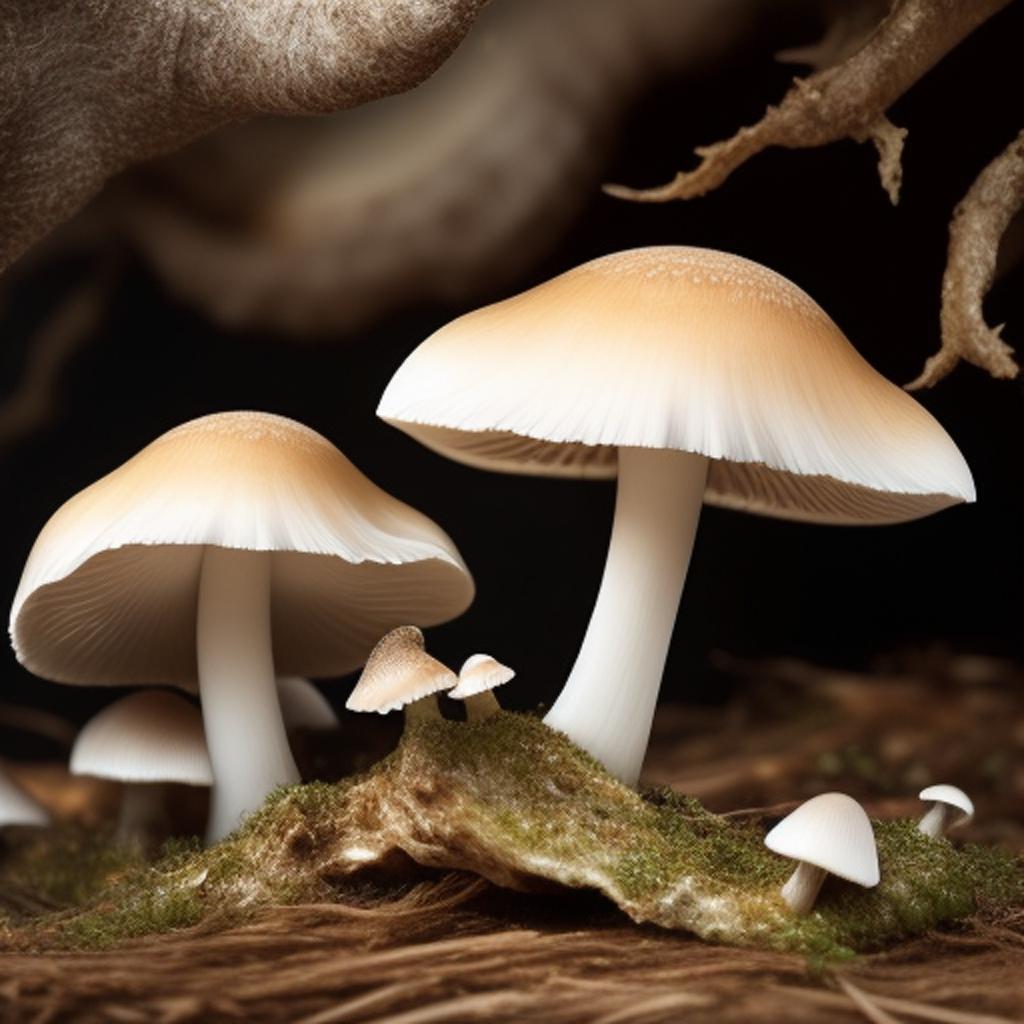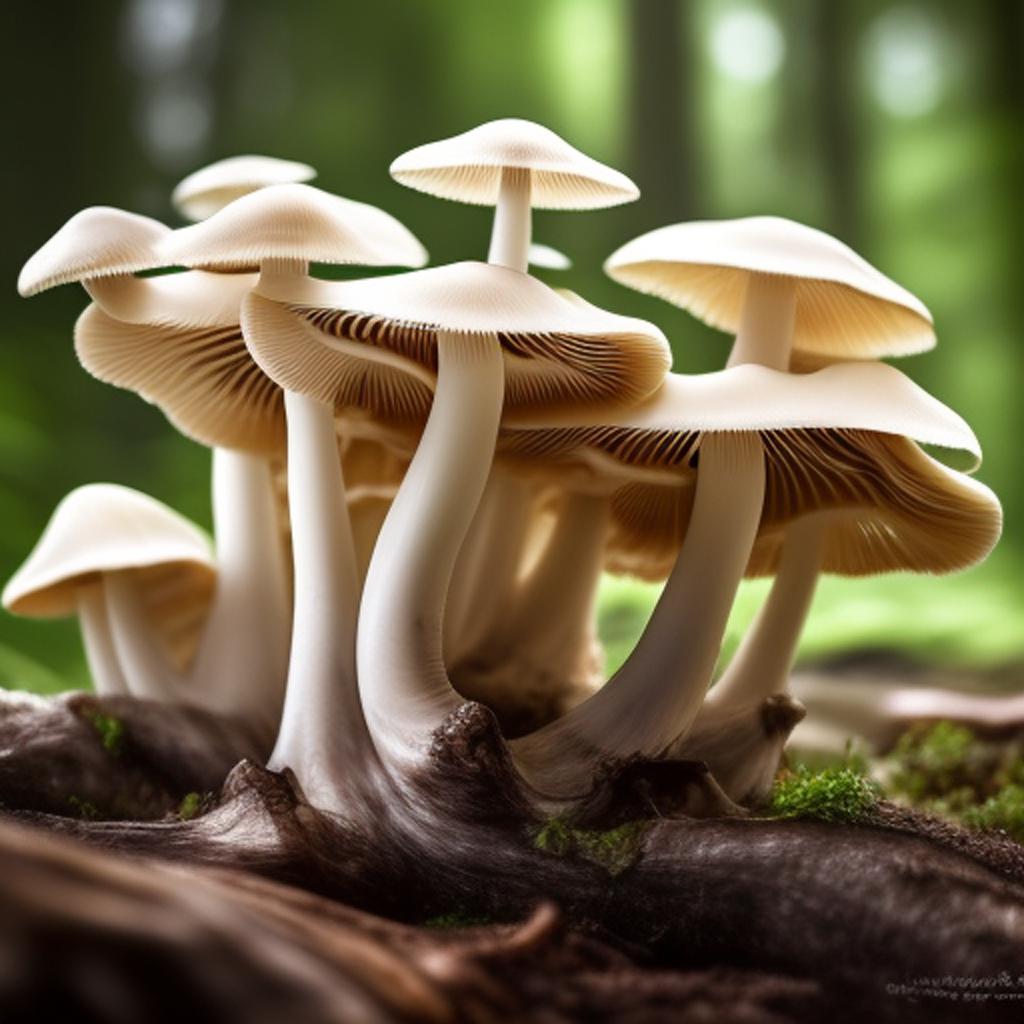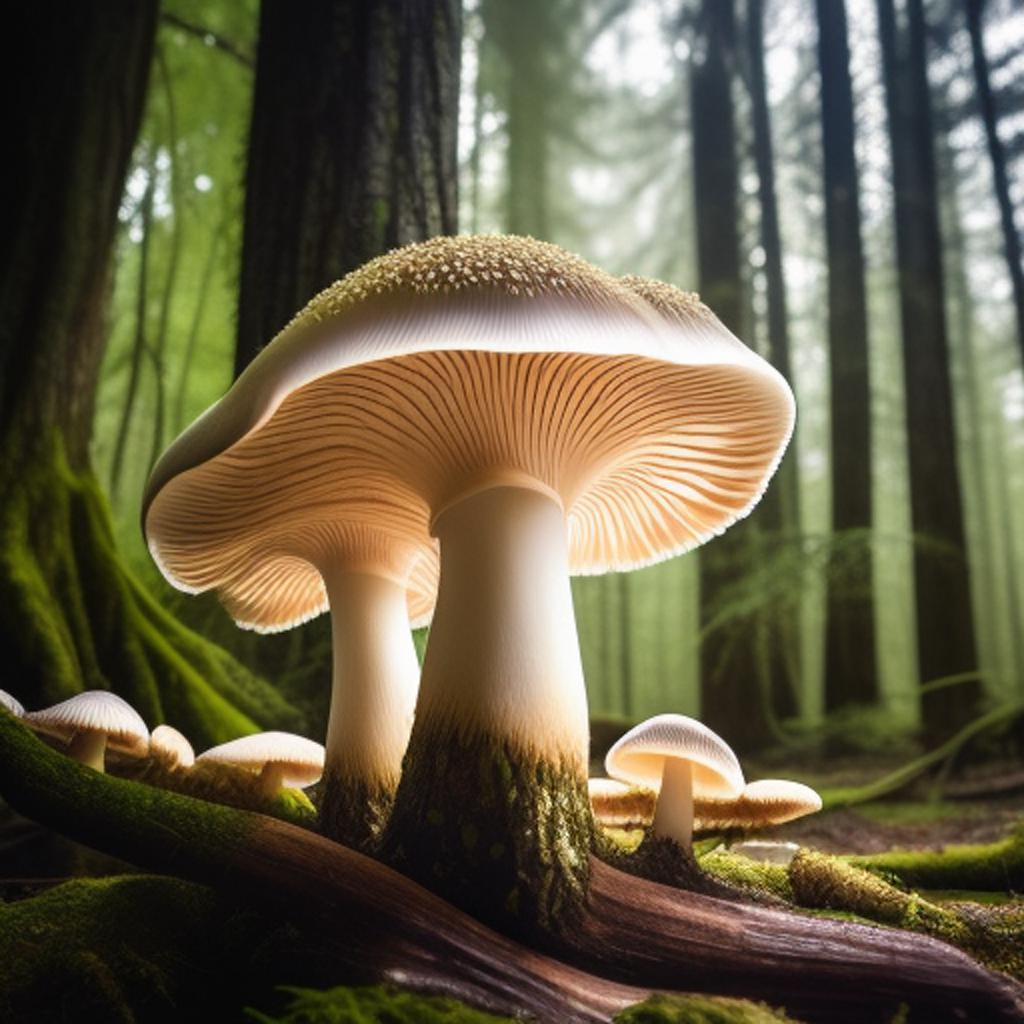Delve into the world of Oyster Mushrooms in Michigan. Uncover its health benefits, explore the vibrant varieties, and learn sustainable growing tips.
Benefits of Oyster Mushrooms
Oyster mushrooms have a rich nutritional profile, providing ample amounts of vitamins B and D, essential amino acids, and dietary fiber, which contribute to overall health. Being low in fat and high in protein, they make an excellent diet addition for health-conscious individuals.
Oyster mushrooms are not only good for you, but they’re also good for the planet. As fast-growing decomposers, they are an integral part of forest ecosystems and can be grown on waste products like straw and coffee grounds, embodying the concept of sustainability in your diet.
Nutritional Value
Oyster mushrooms are lauded in the culinary and health world for their significant array of nutrients, solidifying their place as a desirable addition to a balanced diet.
- Rich in essential vitamins and minerals such as B vitamins, copper, potassium, and iron
- Increased intake can help boost the immune system, support heart health, and assist in maintaining optimal body function
- With low-calorie count and high fiber content, they aid in promoting weight management and regulating digestion
- Their high antioxidant content prevents oxidative stress and inflammation, thus reducing the risk of chronic disease
- A good source of protein for vegetarians and vegans
- Notable for its rich umami flavor profile, adding depth to various dishes
Potential Health Benefits
Oyster mushrooms offer a wealth of potential health benefits. From boosting immunity to managing cholesterol levels and aiding in digestive health, they can serve as a nourishing addition to your diet.
- They are loaded with antioxidants like ergothioneine which help strengthen the immune system.
- The high fiber content assists in smooth digestion and maintains gut health.
- They contain statin compounds that can help reduce bad cholesterol levels.
Environmental Impact
Oyster mushrooms possess an extraordinary trait: the capacity for degrading environmental pollutants, contributing substantially to our planet’s health, and exhibiting a low environmental footprint.
- Break down pollutants in the soil and water
- Can be grown on waste products
- Minimize harmful agricultural runoff
- Replace traditional, high environmental impact protein sources
Varieties of Oyster Mushrooms

A comprehensive guide unveils the vibrant varieties of oyster mushrooms at your disposal. From the savory Blue Oyster to the visually stunning Pink Oyster and the robust Golden and King Oyster mushrooms, each variety brings distinct flavors and aesthetic appeal to culinary dishes.
Oyster mushrooms offer a spectrum of flavors and textures, such as the subtle Blue, visually exciting Pink, and robust Golden and King varieties. Your dish, your choice.
Don’t just pick any oyster mushroom. Cater to your culinary needs by selecting the right variety. For a subtle flavor, go for Blue Oysters. Want a touch of visual excitement? Pink Oysters are your choice. Seeking a meaty consistency? Golden or King Oysters won’t disappoint.
Blue Oyster Mushrooms
Blue Oyster Mushrooms, appreciated for their delicate flavor and velvety texture, find the cold, humid climate of Michigan conducive for growth. These distinctive fungi not only offer gastronomic delights but also unfold a new panorama of sustainable farming.
- Robust nature allowing them to withstand frosty temperatures.
- Adaptable to hardwood substrates commonly found in Michigan.
- Potential to yield multiple flushes leading to high production.
- Exquisite taste and texture enhancing a variety of dishes from soups to sauces.
- Versatility in culinary applications, from grilling, sautéing, to pickling.
Pink Oyster Mushrooms
Pink Oyster Mushrooms, with their vibrant pink hues, bring both aesthetics and great taste to your plate. These flavorful fungi not only transform any dish visually but also deliver a distinct meat-like flavor. Plus, they are believed to have properties that can aid in combating diabetes, making them an alluring addition to any health-conscious meal.
- The bright pink hue of Pink Oyster Mushrooms adds a unique pop of color to various dishes
- Pink Oyster Mushrooms are known for their meat-like flavor, adding depth to vegetarian and vegan dishes
- The potential anti-diabetic properties of Pink Oyster Mushrooms could contribute to maintaining a balanced diet for individuals with diabetes
Golden Oyster Mushrooms
Golden Oyster mushrooms harbor a wealth of hidden health benefits. They’re potent sources of antioxidants, assuring great support to your immune system. Additionally, they’re rich in protein, vitamins, and minerals, making them a nutritious choice for any meal.
These golden delights also contain ergothioneine, a unique antioxidant that might have protective effects on our cells. This not-so-well-known nutritional secret makes them stand out in the realm of edible mushrooms.
Michigan’s farmers are now recognizing the growing demand for Golden Oyster mushrooms. The magical blend of their enticing yellow color, nutritional benefits, and unique taste is attracting food lovers, helping local farmers to boost their product line.
Farmers are also capitalizing on the mushroom’s adaptability. Golden Oysters can be grown in a wide variety of substrates, including straw and hardwood. As such, cultivating these mushrooms is both an eco-friendly and profitable venture for Michigan’s agricultural community.
King Oyster Mushrooms
King Oyster mushrooms bring unparalleled culinary value to your kitchen. They’re renowned for their dense texture and distinct umami flavor. This makes them an excellent meat substitute in various recipes.
Hailing from the Mediterranean region, these mushrooms grow larger than their cousins. They have a long, thick stem and a small cap, differentiating them visually from other Oyster varieties.
The growth process of King Oyster mushrooms is fascinating. Unlike most fungi that prefer damp, dark environments, they require lower humidity and warmer temperatures for optimal growth.
These mushrooms grow vigorously, often reaching their full size within two weeks. This ease of growth, combined with their robust flavor, makes them a popular choice for home cultivation and gourmet dishes.
Growing Oyster Mushrooms in Michigan

Having a thriving oyster mushroom garden in Michigan starts by paying attention to the necessary climatic and soil conditions, the right location, preparation of the growing medium, and appropriate sourcing of oyster mushroom spawn. Regular care of your mushroom patch is also paramount to ensure a sustained production cycle that yields high-quality mushrooms.
Oyster mushroom farming, besides being a hobby, can be a potent economic booster in Michigan. Mushroom cultivation promotes local businesses, and when scaled up, can offer employment while contributing to sustainable food sources. The growing demand for gourmet and medicinal mushrooms further underscores the economic significance of this venture.
Climate and Soil Conditions
Understanding the seasonal changes in Michigan is paramount to successful oyster mushroom cultivation. These fungi thrive in moderate temperatures, with growth inhibited by extreme cold or heat. Monitoring weather patterns provides insight into timing mushroom plantation to coincide with the most conducive seasons.
Notably, the soil composition can monumentally influence the development of oyster mushrooms. These fungi prefer a substrate rich in organic material. Gardeners should ensure a good blend of yard waste, hardwood chips, and straw for an optimal growing medium.
Additionally, Michigan’s rich and loamy soil is ideal for mushroom growth, as it holds moisture well – vital for spore germination and growth. However, excess water can lead to diseases, so good drainage is crucial for a flourishing crop.
Choosing the Right Location
With oyster mushrooms’ unique preference for low light and cool temperatures, it’s critical to select a site providing this optimal microclimate. Strategic location selection can dramatically improve mushroom yield.
Locations that offer indirect sunlight, diffused daylight, or even artificial light can work well. But remember, a temperature range of 55 to 75 degrees Fahrenheit is crucial for grown oyster mushrooms.
The choice of location also underpins the yield of the fungi. A damp, cool place such as a basement or shaded outdoor area promotes mushroom proliferation.
However, avoid areas prone to direct sunlight, excessive heat, drafts, or fluctuating temperatures, as these conditions can hamper mushroom growth and lower yields. Your response to local climatic nuances can indeed weigh heavily on your harvest returns.
Preparation of Growing Medium
In the cultivation of oyster mushrooms, the substrate or growing medium plays a critical role. Comprised mainly of organic materials like straw or wood, the substrate acts as a food source, thus contributing significantly to the fruiting and overall yield of the mushrooms.
The preparation of this substrate is a two-step process. First, the chosen organic material must be thoroughly soaked in water. This hydrates the material and makes it easier for the mushrooms to extract nutrients. After soaking, the substrate needs to be sterilized to eliminate any competing organisms, ensuring the oyster mushrooms can flourish unimpeded.
Sourcing Oyster Mushroom Spawn
The essence of a great mushroom cultivation journey lies in the quality of spawn used. Not all spawn are created equal —some are simply better genotypes for cultivation, providing robust growth and good yields. When sourcing Oyster Mushroom spawn, it’s crucial to engage dependable suppliers who provide quality genetic material.
The genetic makeup of the Oyster Mushroom matters significantly in determining the success of your harvest. In fact, the genetic material of the spawn not only impacts mushroom development but also resistance to diseases and yields. As such, making an informed decision when buying Oyster Mushroom spawn is paramount.
Opting for organically produced Oyster Mushroom spawn can greatly enhance the overall health and productivity of your mushrooms. This, as a result, helps maintain the nutritional integrity and potential health benefits of the mushrooms themselves. Therefore, sourcing responsibly and sustainably produced spawn should be a priority.
Although online marketplaces may offer convenience in sourcing Oyster Mushroom spawn, they may not always provide assured quality. A reliable way to ensure you get quality spawn is by attending local farmers markets, mushroom cultivation workshops, or reliable nurseries often dealing in fungi supplies.
Lastly, it’s well worth considering the longevity and storage of the spawn. Quality spawn should be capable of being stored for a reasonable period without losing viability. Outdated or improperly stored spawn could significantly impact the success of your mushroom cultivation.
Caring for Oyster Mushrooms
The vitality of oyster mushroom development requires a triad of attention to fresh air exchange, light accessibility, and ideal humidity. Maintaining these conditions assures robust mushroom growth and negates the risk of stunted development or premature harvest.
Preemptive action is key in the battle against pests and diseases that can hinder mushroom cultivation. Regular inspection, hygienic practices, and non-chemical pest control methods like introducing beneficial insects can help protect your cultivate.
A diligent eye for early signs of diseases, particularly fungal villains like green molds, is essential. The implementation of biological controls, such as Bacillus species, coupled with good hygiene, can offer a potent defense against these threats.
Harvesting and Using Oyster Mushrooms

Michigan’s oyster mushrooms reach full maturity about 5-10 days after first sprouting, presenting a perfect time for harvesting. Use a clean, sharp knife to cut the cluster at the base cleanly, preventing unnecessary damage to the mycelium.
Ensure optimal use of your harvested oyster mushrooms by storing them in a brown paper bag in the refrigerator. Wash only before use, preventing premature spoilage. Their culinary versatility lets them blend harmoniously in stir-fries, soups, or roasted dishes for a delicate, savory flavor.
Harvesting Techniques
The initial step in harvesting oyster mushrooms involves carefully examining the edges of the fruit bodies; once they begin to curl upwards, it signifies maturity and readiness for harvesting. Use a sharp knife and cut the base of the stem cleanly, to avoid damaging the underlying mycelium and promoting healthy, continuous growth.
Effective harvesting tools, notably sharp knives, foster healthy oyster mushroom colonies. A clean cut, rather than a tear, preserves the integrity of the mycelium in the substrate, fostering regrowth and potentially enhancing overall yield over time.
It’s also essential to rotate the harvest area, ensuring some mushrooms are left behind. The maturity of these unharvested specimens allows spore dispersion for natural propagation, serving a critical step for the longevity of your oyster mushroom colony.
Storage and Preservation
Once harvested, oyster mushrooms’ longevity can be stretched with the right approach. Store them unwashed in a loosely closed paper bag on the refrigerator’s top shelf. Always remember to wash them only before cooking, as early washing can induce spoilage.
Freezing is also a viable preservation method. Blanch the mushrooms first, then pat dry and freeze. This method maintains their nutritional content and texture, offering you a way to enjoy this nutritious delicacy in off-peak seasons.
Think about drying as another preservation method. Drying can be done in a food dehydrator or oven. Once the mushrooms are crisp-dry, store in an airtight jar away from light and moisture. They will keep for up to a year.
If you prefer home canning, oyster mushrooms can be preserved in brine or pickling solution. These methods give the mushrooms a flavorful kick making them ideal in mixed dishes. Implementing these storage and preservation strategies will ensure a year-long supply of this gourmet mushroom even after peak growing season ends.
Cooking and Recipe Ideas
Infusing local Michigan flavors, oyster mushrooms can be pan-seared with cherry wine reduction for a sumptuous side dish or incorporated into a wild rice pilaf showcasing the heart of Midwestern cuisine. The versatility of these fungi allows for unique recipes reflecting the state’s distinctive palate.
Oyster mushrooms offer culinary diversity, enhancing your dining experience with their umami-rich character. Enjoy them in risottos, stir-fries, or gourmet sauces, or even as a meat substitute in plant-based dishes. Their delicate flavor and tender texture allow for creative gastronomic expressions.
Frequently Asked Questions
Oyster Mushrooms in Michigan: Benefits, Varieties, and Growing Tips
What are the benefits of growing oyster mushrooms in Michigan?
Oyster mushrooms offer several benefits for Michigan growers, including easy cultivation, fast growth, high yield potential, and nutritional value.
What are the different varieties of oyster mushrooms that can be grown in Michigan?
Michigan growers can choose from various varieties of oyster mushrooms, such as Pleurotus ostreatus (common oyster), Pleurotus pulmonarius (phoenix oyster), and Pleurotus citrinopileatus (golden oyster).
Where can I buy oyster mushroom spawn in Michigan?
Oyster mushroom spawn can be purchased from local garden centers, online mushroom supply stores, or directly from mushroom farms in Michigan.
What growing conditions are suitable for oyster mushrooms in Michigan?
Oyster mushrooms thrive in cool temperatures, ideally between 55-65°F (13-18°C), with high humidity and indirect light. They can be grown indoors or outdoors, depending on the desired cultivation method.
Are there any specific tips for successfully growing oyster mushrooms in Michigan?
Some helpful tips for growing oyster mushrooms in Michigan include using a suitable substrate (such as straw or sawdust), maintaining proper ventilation, watering adequately, and implementing sterile practices to prevent contamination.
Can oyster mushrooms be grown year-round in Michigan?
While oyster mushrooms can be grown year-round in Michigan, their cultivation may require adjustments to the growing environment, such as temperature and humidity control, to accommodate seasonal changes.
Are there any pests or diseases that affect oyster mushrooms in Michigan?
Common pests and diseases that can affect oyster mushrooms in Michigan include mites, flies, mold, and bacterial contamination. Implementing proper sanitation and monitoring practices can help minimize these risks.
How long does it take for oyster mushrooms to grow in Michigan?
Oyster mushrooms typically take around 5-7 weeks to grow from the initial inoculation of spawn to harvest, depending on environmental conditions and mushroom variety.
What are some culinary uses for oyster mushrooms?
Oyster mushrooms are versatile in the kitchen and can be used in various culinary preparations, such as sautéing, stir-frying, grilling, or adding to soups, stews, and pasta dishes.
Are there any potential health benefits of consuming oyster mushrooms?
Oyster mushrooms are known for their potential health benefits, as they are low in calories, rich in nutrients, and may possess antioxidant and immune-boosting properties. However, consult with a healthcare professional for personalized advice.
Note: The information provided is for educational purposes only and should not replace professional guidance.
Conclusion
Learning to grow your own oyster mushrooms in Michigan not only contributes to local, sustainable food systems, but delivers a joyous hands-on experience with nature. The process, while requiring meticulous care, allows mushroom enthusiasts to harvest a delightful yield of these beneficial fungi.
Oyster mushrooms have etched a significant place in the culinary and environmental world. By cultivating them, you partake in a journey that culminates in a better understanding of fungi and a delightful addition to your meal creations.
- The joy of growing your own food
- Contributing to sustainable food systems
- Exploring the versatile uses of oyster mushrooms
- Partaking an ecologically friendly hobby
- Dishing out a variety of mushroom-infused recipes
- The thrill of unearthing a bounty of home-grown delicacies
